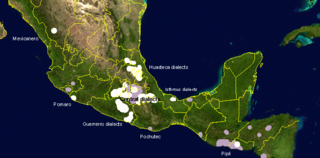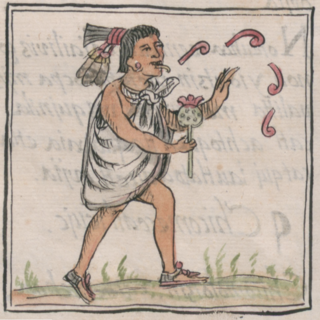Related Research Articles
Cognitive linguistics is an interdisciplinary branch of linguistics, combining knowledge and research from cognitive science, cognitive psychology, neuropsychology and linguistics. Models and theoretical accounts of cognitive linguistics are considered as psychologically real, and research in cognitive linguistics aims to help understand cognition in general and is seen as a road into the human mind.

An image schema is a recurring structure within our cognitive processes which establishes patterns of understanding and reasoning. As an understudy to embodied cognition, image schemas are formed from our bodily interactions, from linguistic experience, and from historical context. The term is introduced in Mark Johnson's book The Body in the Mind; in case study 2 of George Lakoff's Women, Fire and Dangerous Things: and further explained by Todd Oakley in The Oxford handbook of cognitive linguistics; by Rudolf Arnheim in Visual Thinking; by the collection From Perception to Meaning: Image Schemas in Cognitive Linguistics edited by Beate Hampe and Joseph E. Grady.

Uto-Aztecan, Uto-Aztekan or Uto-Nahuatl is a family of indigenous languages of the Americas, consisting of over thirty languages. Uto-Aztecan languages are found almost entirely in the Western United States and Mexico. The name of the language family was created to show that it includes both the Ute language of Utah and the Nahuan languages of Mexico.
Construction grammar is a family of theories within the field of cognitive linguistics which posit that constructions, or learned pairings of linguistic patterns with meanings, are the fundamental building blocks of human language. Constructions include words, morphemes, fixed expressions and idioms, and abstract grammatical rules such as the passive voice or the ditransitive. Any linguistic pattern is considered to be a construction as long as some aspect of its form or its meaning cannot be predicted from its component parts, or from other constructions that are recognized to exist. In construction grammar, every utterance is understood to be a combination of multiple different constructions, which together specify its precise meaning and form.
In linguistics, a grammatical construction is any syntactic string of words ranging from sentences over phrasal structures to certain complex lexemes, such as phrasal verbs.
Eve Eliot Sweetser is a professor of linguistics at the University of California, Berkeley. She received her Ph.D. in Linguistics from UC Berkeley in 1984, and has been a member of the Berkeley faculty since that time. She has served as Director of Berkeley's undergraduate Cognitive Science Program and is currently Director of the Celtic Studies Program.

Numic is the northernmost branch of the Uto-Aztecan language family. It includes seven languages spoken by Native American peoples traditionally living in the Great Basin, Colorado River basin, Snake River basin, and southern Great Plains. The word Numic comes from the cognate word in all Numic languages for “person”, which reconstructs to Proto-Numic as. For example, in the three Central Numic languages and the two Western Numic languages it is. In Kawaiisu it is and in Colorado River, and.

The Nahuan or Aztecan languages are those languages of the Uto-Aztecan language family that have undergone a sound change, known as Whorf's law, that changed an original *t to before *a. Subsequently, some Nahuan languages have changed this to or back to, but it can still be seen that the language went through a stage. The best known Nahuan language is Nahuatl. Nahuatl is spoken by about 1.7 million Nahua peoples.
Frame semantics is a theory of linguistic meaning developed by Charles J. Fillmore that extends his earlier case grammar. It relates linguistic semantics to encyclopedic knowledge. The basic idea is that one cannot understand the meaning of a single word without access to all the essential knowledge that relates to that word. For example, one would not be able to understand the word "sell" without knowing anything about the situation of commercial transfer, which also involves, among other things, a seller, a buyer, goods, money, the relation between the money and the goods, the relations between the seller and the goods and the money, the relation between the buyer and the goods and the money and so on. Thus, a word activates, or evokes, a frame of semantic knowledge relating to the specific concept to which it refers.
Cognitive grammar is a cognitive approach to language developed by Ronald Langacker, which hypothesizes that grammar, semantics, and lexicon exist on a continuum instead of as separate processes altogether. This approach to language was one of the first projects of cognitive linguistics. In this system, grammar is not a formal system operating independently of meaning. Rather, grammar is itself meaningful and inextricable from semantics.
William A. Foley is an American linguist and professor at Columbia University He was previously located at the University of Sydney. He specializes in Papuan and Austronesian languages. Foley developed Role and Reference Grammar in a partnership with Robert Van Valin.

Northern Paiute, endonym Numu, also known as Paviotso, is a Western Numic language of the Uto-Aztecan family, which according to Marianne Mithun had around 500 fluent speakers in 1994. It is closely related to the Mono language.
Cora is an indigenous language of Mexico of the Uto-Aztecan language family, spoken by approximately 30,000 people. It is spoken by the ethnic group that is widely known as the Cora, but who refer to themselves as Naáyarite. The Cora inhabit the northern sierra of the Mexican state Nayarit which is named after its indigenous inhabitants. A significant portion of Cora speakers have formed an expatriate community along the southwestern part of Colorado in the United States. Cora is a Mesoamerican language and shows many of the traits defining the Mesoamerican Linguistic Area. Under the General Law of Linguistic Rights of the Indigenous Peoples, it is recognized as a "national language", along with 62 other indigenous languages and Spanish which have the same "validity" in Mexico.

Colorado River Numic, of the Numic branch of the Uto-Aztecan language family, is a dialect chain that stretches from southeastern California to Colorado. Individual dialects are Chemehuevi, which is in danger of extinction, Southern Paiute, and Ute. According to the Ethnologue, there were a little less than two thousand speakers of Colorado River Numic Language in 1990, or around 40% out of an ethnic population of 5,000.
Proto-Nahuan is a hypothetical daughter language of the Proto-Uto-Aztecan language. It is the common ancestor from which the modern Nahuan languages have developed.

Aztec–Tanoan is a hypothetical and undemonstrated language family that proposes a genealogical relation between the Tanoan and the Uto-Aztecan families. In some forms, Aztec–Tanoan has also included the Zuni isolate. This proposed classification has not been definitively demonstrated, largely because of slow progress in the reconstruction of the intermediate stages of the two language families involved, but is still considered promising by many linguists. The grouping was originally proposed by Edward Sapir in his 1921 classification, but it was not until 1937 that supporting evidence was published by Benjamin Lee Whorf and G. L. Trager. Their proposal included some 67 proposed cognates, but subsequent reviews have found most of them to be unconvincing. A small number of their proposed cognates do seem to have some merit and in his 1997 review of the hypothesis Lyle Campbell states that the proposal is not implausible but requires detailed study. A recent article by Jane H. Hill argues that the evidence cited for the genetic relation by Whorf and Trager is better understood as a result of language contact between the Uto-Aztecan and Tanoan proto-languages.

Nahuatl, Aztec, or Mexicano is a language or, by some definitions, a group of languages of the Uto-Aztecan language family. Varieties of Nahuatl are spoken by about 1.7 million Nahua peoples, most of whom live mainly in Central Mexico and have smaller populations in the United States.
Proto-Uto-Aztecan is the hypothetical common ancestor of the Uto-Aztecan languages. Authorities on the history of the language group have usually placed the Proto-Uto-Aztecan homeland in the border region between the United States and Mexico, namely the upland regions of Arizona and New Mexico and the adjacent areas of the Mexican states of Sonora and Chihuahua, roughly corresponding to the Sonoran Desert and the western part of the Chihuahuan Desert. It would have been spoken by Mesolithic foragers in Aridoamerica, about 5,000 years ago.
The usage-based linguistics is a linguistics approach within a broader functional/cognitive framework, that emerged since the late 1980s, and that assumes a profound relation between linguistic structure and usage. It challenges the dominant focus, in 20th century linguistics, on considering language as an isolated system removed from its use in human interaction and human cognition. Rather, usage-based models posit that linguistic information is expressed via context-sensitive mental processing and mental representations, which have the cognitive ability to succinctly account for the complexity of actual language use at all levels. Broadly speaking, a usage-based model of language accounts for language acquisition and processing, synchronic and diachronic patterns, and both low-level and high-level structure in language, by looking at actual language use.
Irene B. Vogel is an American linguist, specializing in phonology. She is a professor in the University of Delaware Linguistics and Cognitive Science Department, best known for her work on the phonology-syntax interface.